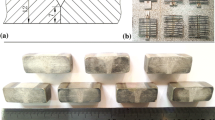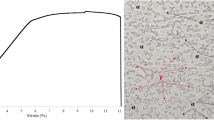Abstract
Homogeneous and heterogeneous PAW (plasma arc welding) experiments were conducted to obtain weld beads with tensile strength of 100% or more compared to that of the base metal in lap joint fillet welding of CP (complex phase) 780 MPa grade high strength steel sheet. Homogeneous and heterogeneous welding mean welding technic without and with welding wire in each. Common basic welding parameters of both homogeneous and heterogeneous PAW wire were applied, including welding speed of 21 cm/min, arc length of 3.5 mm, weaving amplitude of 3 mm, work angle of 30°, and Ar 99.99% shielding gas with 12 L/min. In homogeneous PAW, the optimized additional welding conditions were a welding current of 90 and 95 A, push angle of 20°, and weaving frequency of 5 Hz. The fracture strengths of all the samples were less than that of the base metal, and all fractures occurred at the weld bead fusion zone due to insufficient reinforcement. In heterogeneous PAW, the optimized additional welding conditions were a welding current of 125 A, push angle of 0°, weaving frequency of 4 Hz, and wire feed speeds of 1.53 and 1.38 m/min. Moreover, the welding wire was fed from behind the arc. The fracture strengths of all the samples were greater than that of the base metal, and fractures occurred at the base metal or fusion zone boundary. The reason for higher tensile in heterogeneous PAW wire is deduced as the large cross-section area of reinforcement provided by the welding wire comparing to homogeneous welding. It is well known that small radius of welding heat source clearly produces narrow heat affected zone. Therefore, the PAW produces relatively narrower heat affected zone, then resulted as fully enough strength of weldment. This is another reason of the current achievement.







Similar content being viewed by others
References
De Meester, B. (1997). The weldability of modern structural TMCP steels. ISIJ International, 37(6), 537–551.
Zeman, M. (2009). Assessment of weldability of WELDOX 1100 high-strength quenched and tempered steel. Welding International, 23(2), 73–82.
Lee, G., Kim, H., Jeon, J., Han, S., Han, S. W., & Cho, J. (2022). Development of plasma arc spot welding process and finite element method analysis model for predicting fracture strength: Part 1—Development of plasma arc spot welding process. International Journal of Precision Engineering and Manufacturing, 24(1), 1–11.
Lee, G., Kim, H., Jeon, J., Han, S., Han, S. W., & Cho, J. (2022). Development of plasma arc spot welding process and finite element method analysis model for predicting fracture strength: Part 2—Development of finite element method analysis model for predicting fracture strength. International Journal of Precision Engineering and Manufacturing, 24(1), 13–23.
Choi, J. K., Kang, M. J., Cho, J. H., & Kim, C. H. (2009). Laser welding characteristics of ultra high strength steel for automotive application. Journal of Welding and Joining, 27(5), 1–4.
Kim, J. W., Kang, N. H., Park, Y. D., Kim, D. C., & Kang, M. J. (2014). Effect of strength grades of dual phase steels on failure location and joint efficiency of GMAW lap joints. Korean Journal of Metals and Materials, 52(4), 319–326.
Rybicki, D. J., Mcgee, W. F., & Waldron, D. J. (1995). Ternary gas plasma welding torch. United States Patent: No. 5399831.
Yan, B., Gao, H. M., Lin, W., & Neng, C. A. O. (2010). Influence of plasma-MIG welding parameters on aluminum weld porosity by orthogonal test. Transactions of Nonferrous Metals Society of China, 20(8), 1392–1396.
Mahrle, A., Schnick, M., Rose, S., Demuth, C., Beyer, E., & Füssel, U. (2011). Process characteristics of fibre-laser-assisted plasma arc welding. Journal of Physics D: Applied Physics, 44(34), 345502.
Mahrle, A., Rose, S., Schnick, M., Beyer, E., & Füssel, U. (2013). Laser-assisted plasma arc welding of stainless steel. Journal of Laser Applications, 25(3), 032006.
Van Nguyen, A., Tashiro, S., Ngo, M. H., Le, A. H., Van Bui, H., & Tanaka, M. (2020). Influence of shielding gas composition on molten metal flow behavior during plasma keyhole arc welding process. Journal of Manufacturing Processes, 53, 431–437.
Zhang, C., Wu, C., & Tian, S. (2020). Effect of ultrasonic vibration on current density and keyholing capability of plasma arc. Science and Technology of Welding and Joining, 25(5), 422–430.
Hipp, D., Mahrle, A., Beyer, E., Jäckel, S., Hertel, M., & Füssel, U. (2019). Thermal efficiency analysis for laser-assisted plasma arc welding of AISI 304 stainless steel. Materials, 12(9), 1460.
Ahiale, G. K., Oh, Y. J., Choi, W. D., Lee, K. B., Jung, J. G., & Nam, S. W. (2013). Microstructure and fatigue resistance of high strength dual phase steel welded with gas metal arc welding and plasma arc welding processes. Metals and Materials International, 19(5), 933–939.
Acknowledgements
This work was supported by National Research Foundation of Korea (NRF) grants funded by the Korea government (MSIT) (No. 2021R1A4A1033141 and No. 2021R1F1A1064238), and Korea Evaluation Institute of Industrial Technology (KEIT) grant funded by the Korea government (MOTIE) (No. 20015926) and (No. 20022438), and the BK21 Four program through the National Research Foundation (NRF) funded by the Ministry of Education of Korea (No. 2020142354), and wishes to thank the POSCO technical research laboratory for technical and financial support.
Author information
Authors and Affiliations
Corresponding author
Additional information
Publisher's Note
Springer Nature remains neutral with regard to jurisdictional claims in published maps and institutional affiliations.
Rights and permissions
Springer Nature or its licensor (e.g. a society or other partner) holds exclusive rights to this article under a publishing agreement with the author(s) or other rightsholder(s); author self-archiving of the accepted manuscript version of this article is solely governed by the terms of such publishing agreement and applicable law.
About this article
Cite this article
Han, SW., Shin, S., Kim, H. et al. Plasma Arc Welding of 780CP High Strength Steel Sheet Lap Joint for Tensile Strength of 100% Compared to Base Metal. Int. J. Precis. Eng. Manuf. 25, 925–931 (2024). https://doi.org/10.1007/s12541-024-00957-1
Received:
Revised:
Accepted:
Published:
Issue Date:
DOI: https://doi.org/10.1007/s12541-024-00957-1




